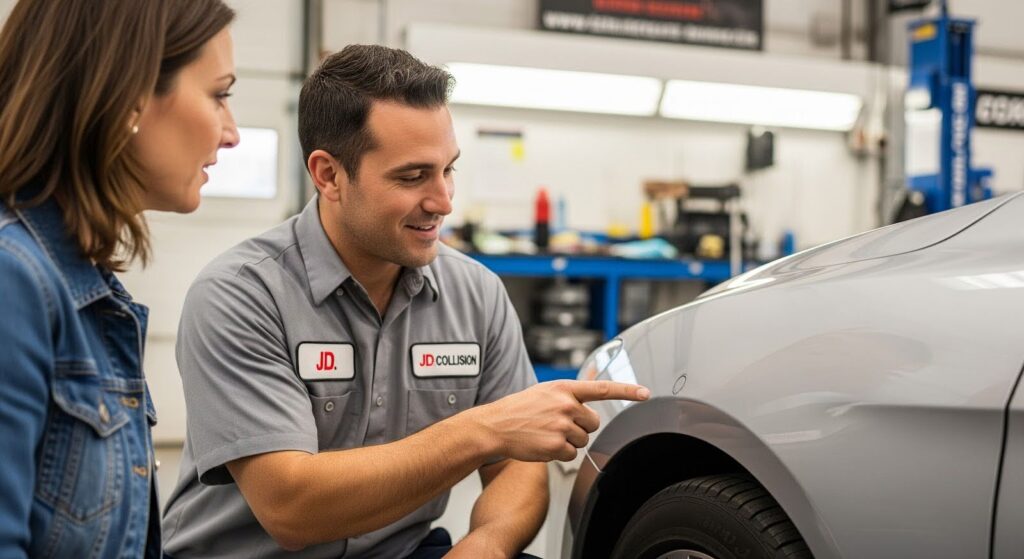BLOG – UNDER THE HOOD

Gravel Roads, Potholes & Paint Chips: The True Cost of Spring Driving in Alberta
You can finally smell it in the air. That unmistakable, muddy, damp smell of the spring thaw in the Lakeland. The mountains of snow are finally shrinking, you’re cracking your window for the first time in months, and the stressful days of winter driving are… over?
Not so fast.
Just as the ice recedes, Alberta’s second damage season begins. It’s the season of the jarring, wince-inducing pothole and the non-stop ping, ping, ping of gravel on your paint.
You’re not imagining it. Poor road conditions cost Canadian drivers a staggering $3 billion annually, and studies show that 32% of all Canadian drivers have experienced pothole damage.
As your local auto body experts in Bonnyville and Cold Lake for over 50 years, we’ve seen it all. The truth is, the damage from a single spring drive can often be more costly and permanent than an entire winter of scraping ice.
Winter damage is obvious. Spring gravel road car damage in Alberta is sneaky. It’s a “slow-burn” problem that starts as a tiny chip in May and reveals itself as an ugly, bubbling rust spot in December.
This guide is about the “true cost” of spring driving. We’ll help you spot the immediate dangers (potholes) and the long-term financial threats (paint chips), so you can protect your vehicle.
The “Sudden Shock”: How Potholes Wreak Havoc

That “WHAM!” moment. You didn’t see it until it was too late. Hitting a deep, sharp-edged pothole is a uniquely Albertan rite of spring, thanks to our aggressive freeze-thaw cycles. We’ve written a full guide on pothole damage before, but the key issue is the shockwave.
The average cost to repair pothole damage is often $300 or more, and can easily climb into the thousands. This jarring impact sends a massive shockwave exactly where your car is most vulnerable: its wheels, tires, and suspension.
What to Listen and Feel For After a Big Hit:
- Tire Damage: Look for visible bulges or “bubbles” on the sidewall of your tire. This is a sign of internal damage, and the tire is now unsafe and at high risk of a blowout.
- Rim Damage: Steel rims might get bent (which can be repaired), but aluminum alloy rims can crack. A cracked rim won’t hold air and must be replaced.
- The “Pulling” Sensation: This is the #1 sign of damage. A Kal Tire study found that 32% of drivers with pothole damage reported their steering started pulling to one side. If you’re now holding your steering wheel slightly off-centre to go straight, your alignment is out.
Ignoring a bad alignment isn’t just annoying; it’s expensive. It will destroy a set of tires in a fraction of their normal lifespan, especially the summer tires you’re about to put on.
The “Slow-Burn”: How Gravel Chips Become Rust Cancer

Potholes are the sudden shock, but gravel roads are the real long-term financial threat. And considering that over 60% of Canada’s public road network is unpaved gravel, this is a daily reality for us in the Lakeland.
Every “ping!” you hear from gravel hitting your rocker panels, hood, or bumper is a potential ticking time bomb.
A $20 touch-up pen from the auto parts store seems like an easy fix, but it’s often just a cosmetic band-aid. A $20 cover-up in May can’t stop a $400 – $2,000+ rust repair bill from showing up a year or two later.
Here’s why.
The 3-Step Journey from “Chip” to “Cancer”
- The Impact: The sharp piece of gravel is a high-velocity missile. It doesn’t just hit your paint; it shatters and blows away the two most important layers of protection: the top Clear Coat and the layer of Paint underneath.
- The Exposure: This impact exposes the raw, unpainted bare metal of your car’s body panel to the open air.
- The “Cancer”: All it takes is moisture and oxygen. Rust (iron oxide) begins to form on that bare metal. It’s a “slow-burn.” You won’t see it for months. The rust doesn’t just sit on top; it creeps under the surrounding “healthy” paint. By the time you see a small, ugly “bubble” in your paint, it’s too late—the metal underneath is already being eaten away.
What started as a 1-inch chip is now a 4-inch-wide pocket of rust that can’t be “touched up.” It has to be professionally ground down, filled, primed, and repainted.
Your Spring Triage Guide: DIY Touch-Up vs. Professional Sealing

Okay, so not every chip is a catastrophe. But how do you know?
When is a DIY Touch-Up Pen “Good Enough”?
Honestly? Almost never, but it’s “better than nothing.” If you have an older, lower-value vehicle and the chip is tiny and superficial (doesn’t look like it’s down to the grey primer or bare metal), a touch-up pen can offer temporary cosmetic cover. But it doesn’t truly seal the metal from moisture.
When Do You Need a Professional Repair?
You need a professional if you see:
- Bare Metal or Primer: If the chip is deep and you can see the grey/silver metal underneath, it must be professionally sealed.
- Any Rust: If you see any brown or orange speckling, the rust has already started.
- Location, Location, Location: If the chip is on a plastic bumper that has sensors (for parking, lane-keeping, etc.), a glob of touch-up paint can actually interfere with the sensor’s operation.
- You Want to Protect Your Investment: If you have a newer vehicle and you care about its resale value, a professional, colour-matched, and sealed repair is the only way to go.
JD COLLISION PRO-TIP: The $1,000 Pothole vs. The 7% Alignment Fix
This is our #1 “cut stress” tip for spring. That bad alignment from a pothole isn’t just annoying; it can cause a 7% decrease in your vehicle’s fuel efficiency. You’re literally paying for it at the pump every single week.
Before you spend $1,000+ on a new set of summer tires, pay the small fee for an alignment check. Don’t let a bad alignment from a single pothole hit in April destroy a new set of tires and cost you hundreds in wasted fuel.
Your “Spring Armour” Plan: How to Fight Back
You can’t avoid every piece of gravel, but you can be proactive.
- Wash Your Car… Thoroughly: The first step is to get the last of that corrosive winter road salt off your car. Spring mud is especially bad because it traps that leftover salt and moisture against your undercarriage.
- Wax On, Damage Off: A good coat of wax (or a more durable ceramic coating) adds a “sacrificial” layer of protection. It might not stop a high-speed rock, but it can help deflect smaller, lighter debris.
- The Pro-Level Defence: Paint Protection Film (PPF): This is the ultimate “to the moon” solution. PPF is a thick, durable, and clear film applied to high-impact areas (like your hood, front bumper, and rocker panels). It’s specifically designed to take the hit from gravel, absorbing the impact so the paint underneath remains perfect. It’s the single best proactive investment you can make to prevent chips from happening in the first place.
- Get a “Spring Check-Up”: This is the easiest, stress-free solution. Before the chips have a chance to turn, bring your car in. We’ll do a quick “chip check” with you, identify any high-risk spots, and professionally seal them. At the same time, we can check your alignment to make sure you’re not slowly shredding your tires.
Don’t Let Spring Cost You Next Winter
The “true cost” of spring driving in Alberta isn’t the annoyance of the ping or the thud. It’s the silent, expensive damage that creeps in afterward.
The paint chip you ignore in May becomes the $2,000 rust bubble you have to pay to fix in December. The “slight pull” from a pothole in April becomes the $1,000 set of tires you have to replace in September.
Don’t let that happen. We’re here to “cut stress, not corners.”
Alberta Spring Driving: Your Top Questions
Q: Can a pothole really “total” my car?
A: It’s extremely rare, but as we covered in our ultimate pothole damage guide, a severe-enough impact can damage critical components like the steering rack or subframe. More often, it leads to a $500 to $3,000 repair for new tires, rims, and alignment.
Q: Is gravel road car damage covered by my Alberta insurance?
A: Pothole damage is typically covered under your Collision policy (and subject to that deductible). Paint chips from gravel are typically covered under your Comprehensive policy. But let’s be honest: is a single $150 paint chip repair worth a $500 deductible and a potential claim on your record? It’s almost always cheaper and smarter to pay out-of-pocket to seal a chip before it becomes a claim.
Q: What’s the difference between a paint chip and a paint scratch?
A: A chip is a small, deep “impact” crater, usually from a rock. A scratch is a long, linear scrape, usually from a key, a branch, or rubbing against something. The repair process is different, but both can lead to rust if they’re down to the metal.
Q: How do you professionally repair a paint chip?
A: We don’t just “cover” it. The process involves: 1) Cleaning the chip of all wax and debris. 2) Carefully removing any surface rust. 3) Applying a layer of rust-inhibiting primer to seal the bare metal. 4) Applying the perfectly colour-matched paint. 5) Applying a final layer of clear coat to protect the paint and make it shine.
Q: How much does it cost to fix one paint chip?
A: The cost varies (starting from $70-$150), but it is infinitely cheaper to professionally seal a one-inch paint chip than it is to repair a six-inch rust bubble that has spread under your paint six months later. An ounce of prevention is truly worth a pound of cure here.